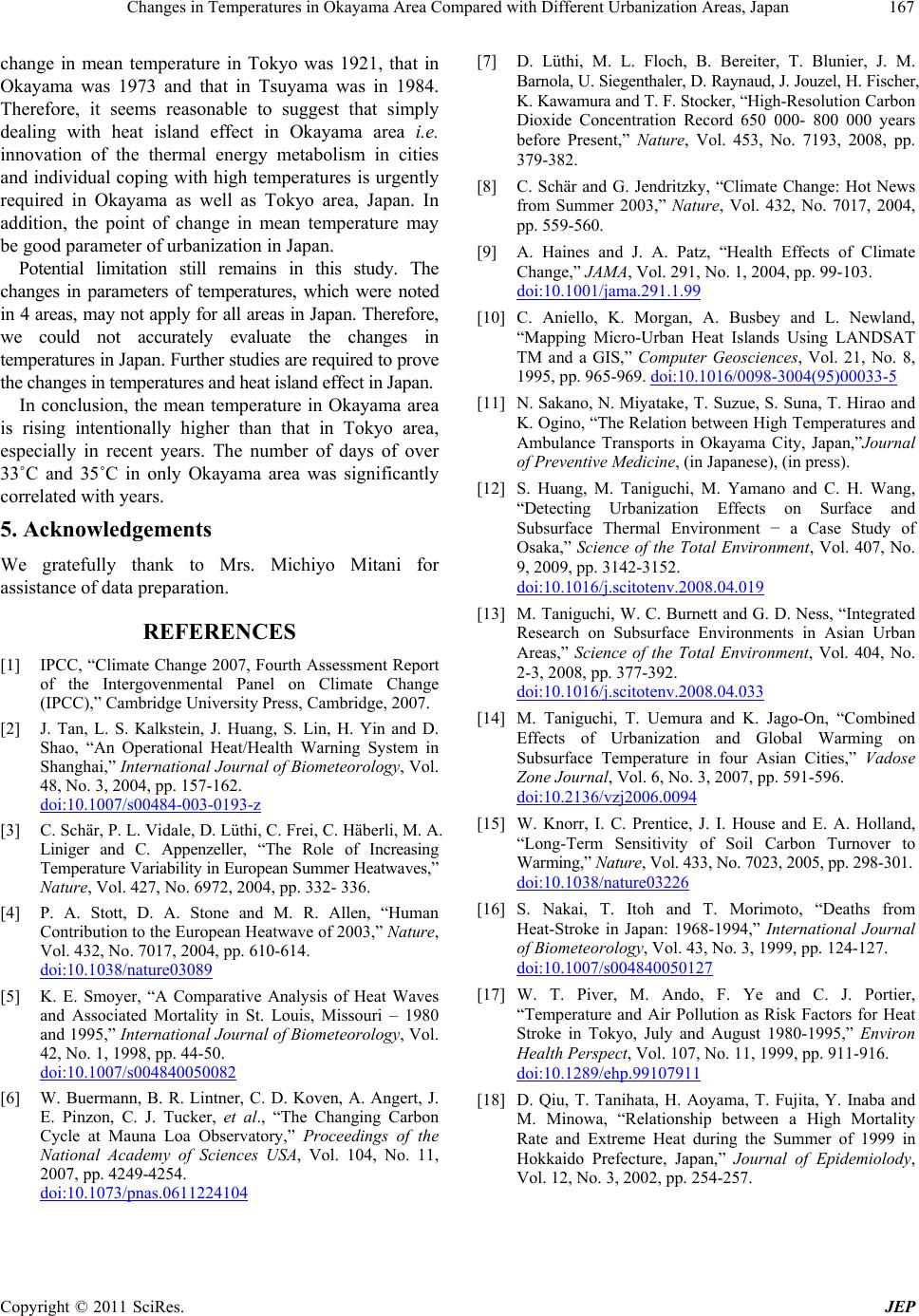
Changes in Temperatures in Okayama Area Compared with Different Urbanization Areas, Japan167
change in mean temperature in Tokyo was 1921, that in
Okayama was 1973 and that in Tsuyama was in 1984.
Therefore, it seems reasonable to suggest that simply
dealing with heat island effect in Okayama area i.e.
innovation of the thermal energy metabolism in cities
and individual coping with high temperatures is urgently
required in Okayama as well as Tokyo area, Japan. In
addition, the point of change in mean temperature may
be good parameter of urbanization in Japan.
Potential limitation still remains in this study. The
changes in parameters of temperatures, which were noted
in 4 areas, may not apply for all areas in Japan. Therefore,
we could not accurately evaluate the changes in
temperatures in Japan. Further studies are required to prove
the changes in temperatures and heat island effect in Japan.
In conclusion, the mean temperature in Okayama area
is rising intentionally higher than that in Tokyo area,
especially in recent years. The number of days of over
33˚C and 35˚C in only Okayama area was significantly
correlated with years.
5. Acknowledgements
We gratefully thank to Mrs. Michiyo Mitani for
assistance of data preparation.
REFERENCES
[1] IPCC, “Climate Change 2007, Fourth Assessment Report
of the Intergovenmental Panel on Climate Change
(IPCC),” Cambridge University Press, Cambridge, 2007.
[2] J. Tan, L. S. Kalkstein, J. Huang, S. Lin, H. Yin and D.
Shao, “An Operational Heat/Health Warning System in
Shanghai,” International Journal of Biometeorology, Vol.
48, No. 3, 2004, pp. 157-162.
doi:10.1007/s00484-003-0193-z
[3] C. Schär, P. L. Vidale, D. Lüthi, C. Frei, C. Häberli, M. A.
Liniger and C. Appenzeller, “The Role of Increasing
Temperature Variability in European Summer Heatwaves,”
Nature, Vol. 427, No. 6972, 2004, pp. 332- 336.
[4] P. A. Stott, D. A. Stone and M. R. Allen, “Human
Contribution to the European Heatwave of 2003,” Nature,
Vol. 432, No. 7017, 2004, pp. 610-614.
doi:10.1038/nature03089
[5] K. E. Smoyer, “A Comparative Analysis of Heat Waves
and Associated Mortality in St. Louis, Missouri – 1980
and 1995,” International Journal of Biometeorology, Vol.
42, No. 1, 1998, pp. 44-50.
doi:10.1007/s004840050082
[6] W. Buermann, B. R. Lintner, C. D. Koven, A. Angert, J.
E. Pinzon, C. J. Tucker, et al., “The Changing Carbon
Cycle at Mauna Loa Observatory,” Proceedings of the
National Academy of Sciences USA, Vol. 104, No. 11,
2007, pp. 4249-4254.
doi:10.1073/pnas.0611224104
[7] D. Lüthi, M. L. Floch, B. Bereiter, T. Blunier, J. M.
Barnola, U. Siegenthaler, D. Raynaud, J. Jouzel, H. Fischer,
K. Kawamura and T. F. Stocker, “High-Resolution Carbon
Dioxide Concentration Record 650 000- 800 000 years
before Present,” Nature, Vol. 453, No. 7193, 2008, pp.
379-382.
[8] C. Schär and G. Jendritzky, “Climate Change: Hot News
from Summer 2003,” Nature, Vol. 432, No. 7017, 2004,
pp. 559-560.
[9] A. Haines and J. A. Patz, “Health Effects of Climate
Change,” JAMA, Vol. 291, No. 1, 2004, pp. 99-103.
doi:10.1001/jama.291.1.99
[10] C. Aniello, K. Morgan, A. Busbey and L. Newland,
“Mapping Micro-Urban Heat Islands Using LANDSAT
TM and a GIS,” Computer Geosciences, Vol. 21, No. 8,
1995, pp. 965-969. doi:10.1016/0098-3004(95)00033-5
[11] N. Sakano, N. Miyatake, T. Suzue, S. Suna, T. Hirao and
K. Ogino, “The Relation between High Temperatures and
Ambulance Transports in Okayama City, Japan,”Journal
of Preventive Medicine, (in Japanese), (in press).
[12] S. Huang, M. Taniguchi, M. Yamano and C. H. Wang,
“Detecting Urbanization Effects on Surface and
Subsurface Thermal Environment − a Case Study of
Osaka,” Science of the Total Environment, Vol. 407, No.
9, 2009, pp. 3142-3152.
doi:10.1016/j.scitotenv.2008.04.019
[13] M. Taniguchi, W. C. Burnett and G. D. Ness, “Integrated
Research on Subsurface Environments in Asian Urban
Areas,” Science of the Total Environment, Vol. 404, No.
2-3, 2008, pp. 377-392.
doi:10.1016/j.scitotenv.2008.04.033
[14] M. Taniguchi, T. Uemura and K. Jago-On, “Combined
Effects of Urbanization and Global Warming on
Subsurface Temperature in four Asian Cities,” Vadose
Zone Journal, Vol. 6, No. 3, 2007, pp. 591-596.
doi:10.2136/vzj2006.0094
[15] W. Knorr, I. C. Prentice, J. I. House and E. A. Holland,
“Long-Term Sensitivity of Soil Carbon Turnover to
Warming,” Nature, Vol. 433, No. 7023, 2005, pp. 298-301.
doi:10.1038/nature03226
[16] S. Nakai, T. Itoh and T. Morimoto, “Deaths from
Heat-Stroke in Japan: 1968-1994,” International Journal
of Biometeorology, Vol. 43, No. 3, 1999, pp. 124-127.
doi:10.1007/s004840050127
[17] W. T. Piver, M. Ando, F. Ye and C. J. Portier,
“Temperature and Air Pollution as Risk Factors for Heat
Stroke in Tokyo, July and August 1980-1995,” Environ
Health Perspect, Vol. 107, No. 11, 1999, pp. 911-916.
doi:10.1289/ehp.99107911
[18] D. Qiu, T. Tanihata, H. Aoyama, T. Fujita, Y. Inaba and
M. Minowa, “Relationship between a High Mortality
Rate and Extreme Heat during the Summer of 1999 in
Hokkaido Prefecture, Japan,” Journal of Epidemiolody,
Vol. 12, No. 3, 2002, pp. 254-257.
Copyright © 2011 SciRes. JEP